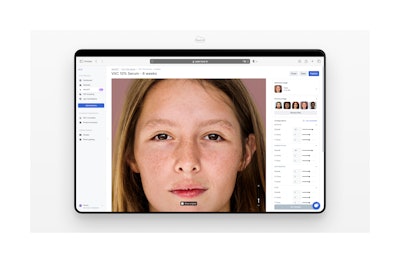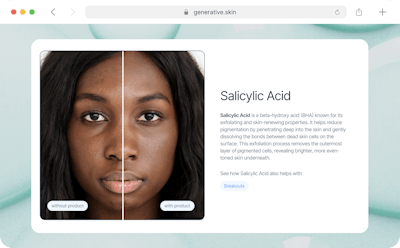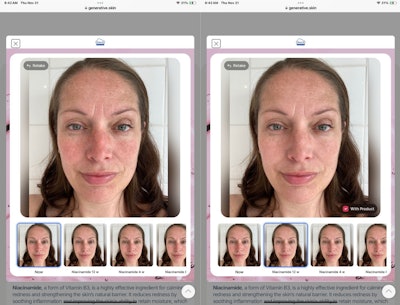ULTA-backed beauty tech company, Haut.AI has announced its SkinGPT & GenerativeSkin technologies are now available for commercial use.
SkinGPT can visually generate and predict what effects certain external factors, like UV exposure, active ingredients or skin care products, will have on a consumer’s skin over time. This is a B2B product that enhances the beauty retail experience, per the company.
SkinGPT also raises awareness of the adverse effects of environmental factors such as allergens, solar insolation and pollution on the skin. These factors can influence the skin long term, causing prolonged inflammation. However, consumers often ignore the consequences. SkinGPT helps visualize their effects over the months and years and shows why it’s worth taking preventative measures.
GenerativeSkin is a D2C visual library of skin care ingredient effects utilizing SkinGPT— a direct solution for the Gen Z trend of using ChatGPT as a dermatologist, and could help deter “Sephora Kids’” use of actives like retinol.
We had the opportunity to speak with HautAI’s founder and CEO, Anastasia Georgievskaya, regarding the commercial launch of these new technologies and how SkinGPT and GenerativeSkin are setting new standards in the beauty and skin care industries.
Realistic Visual Forecasts of Skin Exposure Effects
Georgievskaya: “At the core of Haut.AI’s SkinGPT is the idea of a personal ‘baseline’—that is, we analyze each user’s current skin condition, including factors like redness, pigmentation, wrinkles, or texture. From there, SkinGPT applies information learned from real world data to generate a visual representation of expected changes to skin under various situations.
A standard filter, by contrast, applies the same effect to everyone’s photo without taking individual skin biology into account. SkinGPT, on the other hand, is rooted in data from clinical trials and lab research. It is not just ‘smoothing out’ skin; it is using science-backed inputs and advanced AI models to forecast genuine biological changes. With SkinGPT, marketers simply upload a ‘before’ image, apply a product effect model based on clinical data, and instantly generate a realistic ‘after’ image.Haut.AI
With SkinGPT, marketers simply upload a ‘before’ image, apply a product effect model based on clinical data, and instantly generate a realistic ‘after’ image.Haut.AI
By focusing on each person’s baseline skin condition and combining that with real clinical insights, SkinGPT delivers much more realistic projections than what you’d get from a typical beauty filter. It’s designed to show scientifically plausible outcomes—for example, how the skin might look if you apply a product regularly for a certain period of time.”
Realistic Forecasts for Particular Products
Georgievskaya: “SkinGPT can provide realistic forecasts for specific skincare products or treatments by drawing on real clinical data. If a brand has, for example,real data showing how their serum reduces redness or boosts hydration, SkinGPT can learn from this data and apply similar changes to skin for each individual. This way, customers can see how their skin might actually respond to that product.” Example image of the potential long term results of using salicylic acid for skin care.Haut.AI
Example image of the potential long term results of using salicylic acid for skin care.Haut.AI
SkinGPT to Sharpen Marketing and Drive Product Innovation
Georgievskaya: “SkinGPT is incredibly powerful for marketing teams who often struggle to produce compelling before-and-after visuals. In many cases, clinical images aren’t aesthetically polished enough for campaigns, or the brand has to wait months for results before they can share them. What typically happens is a time-consuming photo editing process to recreate those clinical transformations on more appealing images—sometimes it can take hours just to produce one set of visuals.
With SkinGPT, all of this can be done in seconds. Marketers simply upload a ‘before’ image, apply a product effect model based on clinical data, and instantly generate a realistic ‘after’ image that’s both visually pleasing and scientifically credible.
Even better, SkinGPT offers a highly engaging way to showcase a product’s value. Instead of relying on static before-and-after images or text-heavy claims, brands can let consumers virtually ‘try on’ the product to see how it might improve their skin.
On the product innovation side, brands can leverage SkinGPT to explore new formulations and understand how they might perform across different skin types or demographics. For instance, by uploading clinical trial data into SkinGPT, R&D teams can simulate real-world conditions at a larger scale—beyond the cohort actually tested. That not only speeds up the product development cycle but also provides deeper insights into how a formula could be refined or targeted more precisely. Ultimately, this can lead to more effective, consumer-centric skincare solutions.” Example of GenerativeSkin forecasting the potential results of using niacinamide in a daily skin care routine.Haut.AI
Example of GenerativeSkin forecasting the potential results of using niacinamide in a daily skin care routine.Haut.AI
GenerativeSkin & Gen Alpha
Georgievskaya: “Gen Alpha is growing up in a social media landscape where influencers often guide purchasing decisions, but what works for one’s skin won’t necessarily work for someone else. That’s where ‘Generative Skin’ helps bridge the gap. It’s a platform built on publicly available, peer-reviewed research for each ingredient, and it lets Gen Alpha—and anyone else—see for themselves, in an engaging way, what the most popular ingredients used in skin care, like vitamin C or hyaluronic acid, can potentially do for their skin.
On top of that, we know younger consumers have little patience for lengthy product descriptions. They’re used to snackable, short-form content. With ‘Generative Skin,’ you don’t need to dive into long explanations to figure out what an ingredient does. You just upload a photo, see a realistic simulation of the possible effect, and if you’re curious, there’s a concise text summary right there. This means users actually learn what they need without scrolling through dense scientific jargon.
The hope is that by making these ingredient claims so visual and easy to understand, everyone will become more informed shoppers. Next time they see these ingredients on a product label, they’ll at least know what they’re for—and hopefully make choices that are less likely to harm their skin.”
E-Commerce Spaces Vs Brick-and-Mortar Shops
Georgievskaya: “In e-commerce, SkinGPT brings a highly personalized and interactive element to the shopping experience. Rather than just looking at a product’s description or stock images, consumers can upload a photo, see how the product’s active ingredients might work on their own skin, and explore realistic before-and-after projections—all in real time. This can significantly boost conversion rates because shoppers feel more confident about their choices.
Meanwhile, in brick-and-mortar shops, SkinGPT can be integrated through in-store kiosks or mobile apps that let customers scan a product’s QR code and virtually ‘try it on’ right there. Traditionally, it’s been hard to offer a ‘test’ of skincare in-store because results appear over weeks, not minutes. With SkinGPT, customers can visualize potential outcomes on the spot, blending the convenience of digital interactivity with the tactile experience of physical retail.”
Diagnostic Tools for Engaging Consumers and Building Trust
Georgievskaya: “Diagnostic tools really make all the difference in today’s skin care market. There are so many products out there, each one claiming something amazing—so how do you know what to believe? That’s where the diagnostic tools come in. They provide that immediate insight that consumers crave. When a brand can show someone their unique skin metrics or a clear visual on your own skin—like highlighting areas of redness or predicting how a product might reduce pigmentation—it instantly feels more credible.
People today are increasingly shopping for results rather than just a brand name or fancy packaging. They want to see how a product will actually affect their skin. So, the key is making those results tangible. When you can visualize what’s happening—how a product will treat wrinkles or diminish dark spots—it’s no longer just marketing speak; it’s something you can actually see and relate to. That level of personalization fosters genuine trust. Consumers feel like the brand understands their needs, rather than throwing out a one-size-fits-all promise.”
Transforming Skin Care Decisions with Advanced Diagnostic Tools
Today’s consumers are result-oriented—they’re no longer swayed by packaging or lofty promises alone. They demand proof, and diagnostic platforms like SkinGPT and GenerativeSkin provide that proof in a tangible, engaging way. Whether it’s predicting the effect of anti-aging serums or showcasing the benefits of hydrating ingredients, these tools can help brands stand out while empowering consumers to make informed choices.















